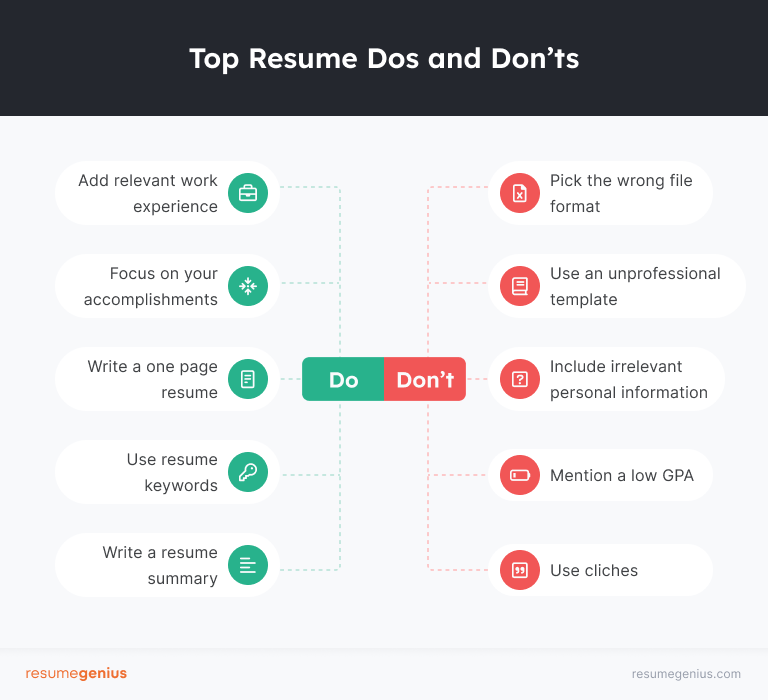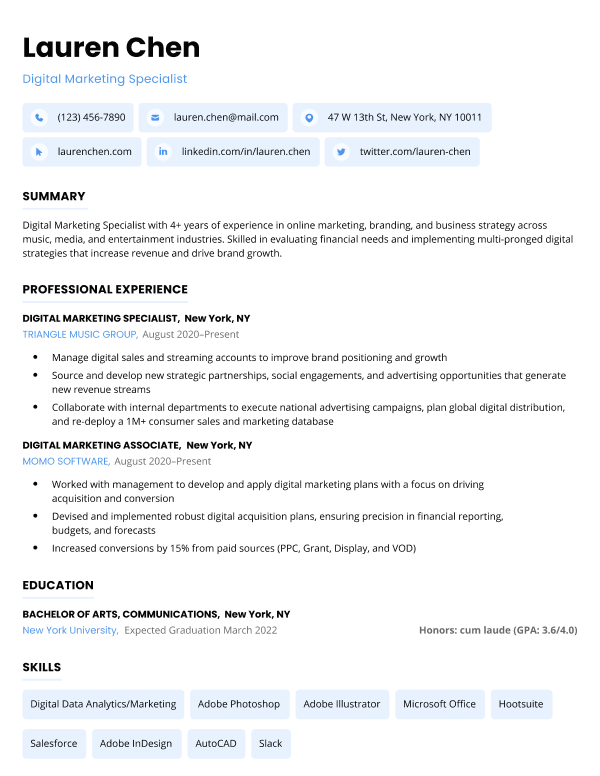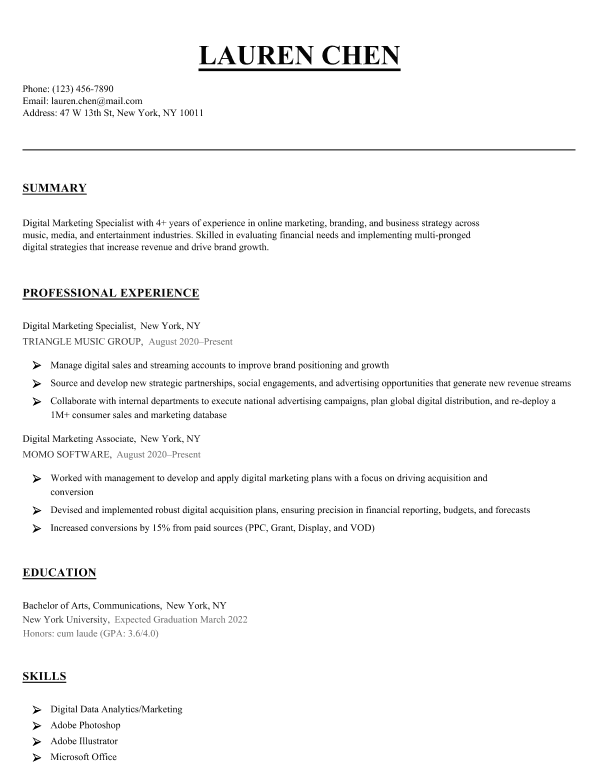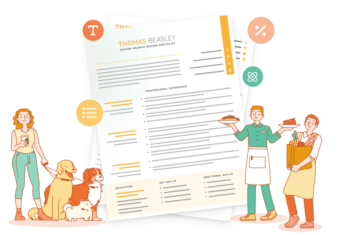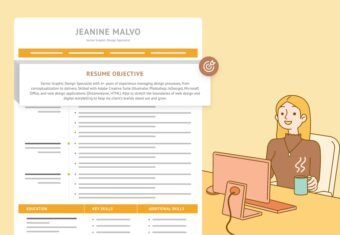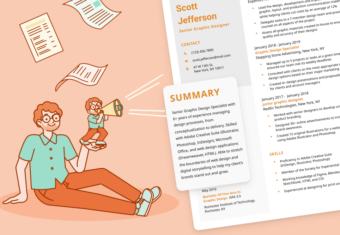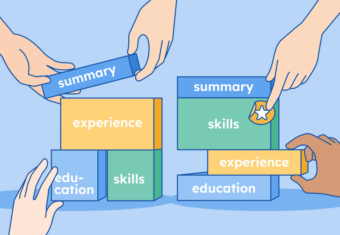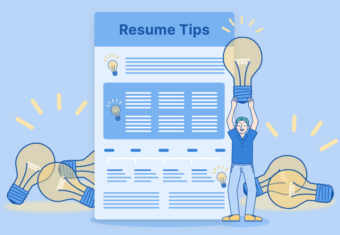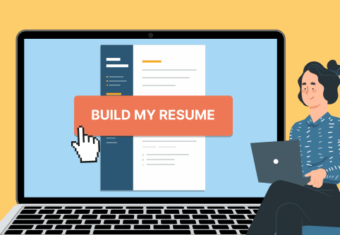When it comes to resumes, there are many pitfalls to be aware of. It’s no surprise that job seekers of all experience levels find writing a resume to be the most challenging part of a job hunt.
However, it doesn’t have to be difficult. Below you’ll find a list of dos and don’ts of resume writing, as well as expert resume tips to help you create a strong application.
1. The dos and don’ts of listing your work experience
Here are some do’s and don’ts for listing work experience on your resume:
Do add job-relevant experience to your resume
Recent resume statistics show that a majority of employers want job applicants to submit targeted resumes.
To impress these hiring managers, you should customize your resume for each job listing by highlighting experience that will help you excel in that specific role.
Targeting your resume to the position shows the hiring manager you’ve familiarized yourself with the job description and know what the job entails.
Don’t include every life experience on your resume
Not all of the experience you’ve gained throughout your life will be relevant to every position. If the job ad doesn’t mention a certification and it won’t prove that you have skills the employer is looking for, then don’t include it on your resume.
Listing irrelevant experiences or certifications on your resume makes you look like you didn’t read the job posting, are sending out bulk resumes, and don’t care about the job.
Our free-to-use resume builder can make you a resume in as little as 5 minutes. Just pick the template you want, and our software will format everything for you.
2. Dos and don’ts for choosing a resume format
Here’s what to do (and not to do) when picking a format for your resume:
Do use a chronological resume format
Almost every job seeker should choose the chronological resume format.
HR departments prefer chronological resumes because they:
- Show career progression
- Can be used by job seekers of all skill levels and industries
- Make it easy to get an instant overview of your qualifications
Even if you’re a recent graduate who lacks work experience, you can still write a chronological resume by highlighting internships, volunteer work, or other experience relevant to the job.
Don’t use a functional format (unless you have employment gaps)
Most likely, your work experience is your greatest selling point. The reason most job seekers shouldn’t use a functional resume is that it downplays your work experience by focusing on your skill set rather than your work history.
The only time you should consider using a functional resume is if you have employment gaps over 6 months long or are switching to a new industry where your current work experience isn’t relevant.

The best format for your resume
Learn how to pick a resume format that highlights your strengths and downplays your weaknesses by reading our HR-approved guide.
3. Resume introduction dos and don’ts
Got questions about resume introductions? Here are the top do’s and don’ts:
Do introduce yourself with a resume summary
Starting your resume off right is an important first step toward getting an interview.
Use a resume summary to highlight your biggest professional strengths, giving employers some context to see if you’re right for the job.
Don’t focus on your own goals instead of the employer’s needs
Think of your resume summary as a brief sales pitch that shows employers what you have to offer the company. Instead of explaining what you expect to get out of the job, mention what you aim to achieve if hired and what skills you have that will help you reach these goals.
By phrasing your resume summary this way, you convey an understanding of the company’s needs and how you can help meet those needs.
4. Top dos and don’ts for adding resume keywords
Resume keywords are key to writing an effective resume, but there’s a right and a wrong way to use them.
Do include keywords throughout your resume
Using resume keywords ensures your resume has all the information hiring managers need to see that you’re a good candidate for the role.
These keywords are skills, experience, certifications, and personality traits that describe the employer’s ideal employee. Usually, you can find resume keywords in the job description of the job ad.
Don’t stuff your resume with keywords
While it’s good to add as many different keywords as you can to your resume, try to avoid including too many.
Stuffing keywords just for the sake of looking qualified makes your resume repetitive and takes up space that could’ve been used to highlight other qualities that make you a strong candidate.
Instead, try to write resume bullet points with different keywords that show you’re a well-rounded candidate.
5. Do’s and don’ts of including personal information
Below are some do’s and don’ts for including personal information on your resume:
Do include your name, email address, and telephone number
It doesn’t matter how qualified you are if the hiring manager doesn’t know how to reach you.
Always include your personal phone number or email address in the contact information section of your resume. However, avoid using your current office number or email if your boss doesn’t know you’re looking for a new job.
Make sure your email address is professional. Ideally, it should just be your name (for example, paulinedelaney@gmail.com).
Don’t mention your nationality, date of birth, age, race, sex, religion, or political affiliation
None of these details are relevant to your ability to do the job. And while discrimination based on any of these factors is illegal, some hiring managers do it subconsciously.
Additionally, modern resumes don’t need to include a mailing address. They’re unnecessary because the job application process is now done by phone and email.
However, if you’ve recently relocated, put your new address on your resume (or at least your city or state) to show employers you’re a local candidate. This is particularly vital if your resume lists past jobs in a different city.
6. Dos and don’ts for your education section
Here are two important rules for your education section:
Do include your highest degree
Listing your highest degree in your resume’s education section shows your level of education, your ability to learn new things, and your determination to succeed.
However, if that degree is a high school diploma and you have years of experience in your field already, there’s no need to include it. Instead, highlight any job-relevant training or certifications you’ve received.
Don’t include your GPA if it’s lower than 3.5
Graduating with a strong GPA is an impressive accomplishment that you can list on your resume, but anything lower than a 3.5 likely won’t work in your favor because other candidates might have higher GPAs.
You also shouldn’t include your GPA on your resume if you’re not a recent graduate. If you already have a few years of relevant work experience, employers are more interested in seeing your work experience than your GPA.
7. Two dos and don’ts for highlighting accomplishments
Keep these do’s and don’ts in mind when highlighting your accomplishments on your resume:
Do include accomplishments in your experience bullet points
Similar jobs have a similar set of duties, so just telling a hiring manager what your responsibilities were in past roles doesn’t help them evaluate you as a candidate. But explaining how you excelled at those duties does.
Waiting tables, for example, is basically the same everywhere. So instead of saying that you waited tables, state how you:
- increased sales
- successfully used upselling techniques
- trained new hires
- Improved customer satisfaction rates
Express your accomplishments using numbers and percentages to strengthen your resume.
Don’t use cliches in your work history bullet points
Almost every job applicant says that they’re “hard-working,” “motivated,” and “detail-oriented.” Choose more specific resume adjectives to better illustrate what you bring to the team.
When you use the same adjectives everyone else uses on their resume, it makes it difficult for your application to stand out. Instead of calling yourself a “team player, for example, use more engaging words like “cooperate,” “support,” and “assist”.
8. Resume length dos and don’ts
This will help you catch (and keep) hiring managers’ attention:
Do limit your resume to one page
You should include as many relevant skills, experiences, and certifications on your resume as possible. But don’t clutter it with so much information that the hiring manager can’t find the details relevant to the role.
For the majority of job applicants a one page resume will be the best choice, allowing you to convey why you’re an ideal candidate while keeping your resume concise and easy to skim for a busy hiring manager.
There are a few exceptions, however. If you have 10+ years of relevant experience, are applying for a senior leadership position, are writing an academic CV, or work in a highly technical field, you can have a two-page resume (or even longer).
Don’t make your resume shorter than one page
If your resume is shorter than one page, employers will think it’s because you don’t have enough skills and experience to fill a full page.
If you’re a high school or college student without any work experience, writing a one-page resume might seem like an impossible task. Fortunately, there’s other relevant experience you can add to your resume.
For example, listing babysitting experience shows that you’re responsible, and including personal projects demonstrates both initiative and the ability to manage your workload effectively.
9. The dos and don’ts of selecting a resume template
There are many resume template options out there. Here’s how to pick the best one for your application:
Do use a template suitable for your industry
While the content of your resume is ultimately what will lead a hiring manager to either reject your application or invite you to an interview, the right resume template can help you make a positive first impression.
A classic black-and-white template is always a good choice no matter what industry you’re in. But if you want something with more color, navy blue, maroon, and dark green are some of the best colors for your resume and are also suitable for formal industries like finance and law.
If you’re in a less formal field and want to show off your creativity or graphic design skills, you have a bit more flexibility when it comes to color and style options. Just make sure your resume still looks professional.
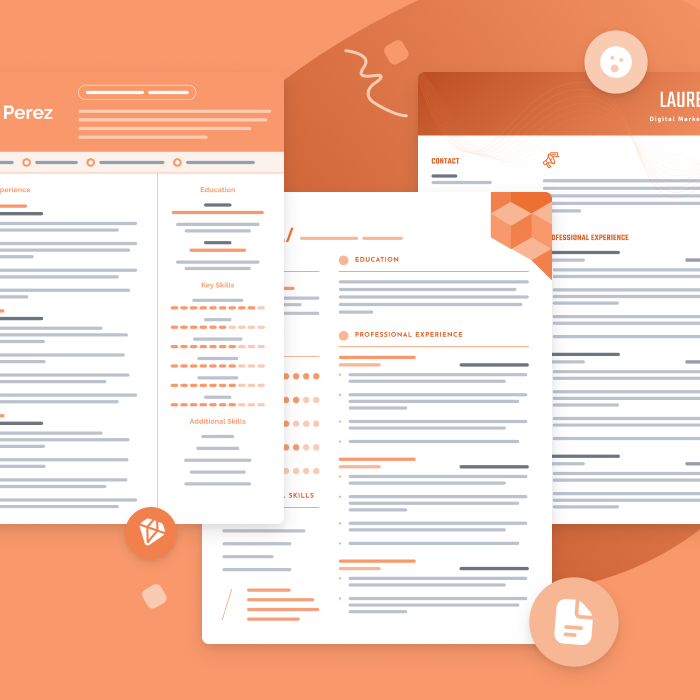
The best resume templates for 2024
One of the best ways to make your resume is by filling out one of our free resume templates. All our templates are designed by experts and free to download for Microsoft Word or Google Docs.
Don’t choose a template with distracting graphics
Some templates you’ll find online aren’t suitable for a job application. They might be attention-grabbing and unique, but sometimes it’s for the wrong reasons.
It’s best to avoid resume templates with too many graphics and other distracting design elements.
Using distracting templates can lead hiring managers to believe that you’re not a serious applicant or aren’t familiar with the standards and expectations of the industry. Additionally, It draws attention away from your accomplishments.
10. Dos and don’ts for including additional resume sections
Here are some do’s and don’ts related to resume sections:
Do add sections that will strengthen your resume
In some cases, you should include additional sections on your resume besides the standard ones found on all resumes (a resume summary, work experience, education, and skills section).
For example, if it’s a role that requires you to speak multiple languages, adding a language skills section can help you demonstrate your language abilities. Or, if you’re writing an IT resume, add a projects section to showcase your computer skills.
Don’t include irrelevant sections
Don’t add additional resume sections if they’re not going to prove that you have a certain skill set that makes you an excellent fit for the role.
It’ll water down your resume, making it less impactful. Additionally, hiring managers might think that you don’t understand what qualities they look for in a candidate, signaling that you didn’t pay attention to the job description or are sending out generic resumes to multiple companies.
Click to rate this article
4.6 Average rating



